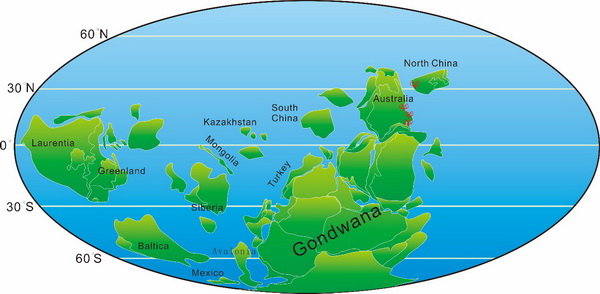Tommotiids are a group of Early Cambrian fossils with multiple small organophosphatic sclerites, and are a kind of extraordinary animals occurring during the Cambrian Explosion. Due to lack of well-preserved scleritome fossils, their zoological affinities had been uncertain for a long time. Over the past years, discovery and study of some articulated scleritomes indicate that tommotiids may belong to stem-group brachiopods. Though their soft-part anatomy is hitherto unknown, it has been argued that bivalved brachiopod shells probably evolved from an Eccentrotheca-like stem group ancestor through intermediary forms (e.g. Paterimitra pyramidalis) by the successive stages of sclerite reduction, specialization and tube shortening. Although tommotiids are common and globally distributed in the Lower Cambrian, they were not discovered from North China Platform yet.
Recently, PhD candidate PAN Bing from the Nanjing Institute of Geology and Palaeontology, Chinese Academy of Sciences and colleagues from Australia and Sweden reported the first discovery of the tommotiid Paterimitra pyramidalis from the Lower Cambrian Xinji Formation of North China Platform. Paterimitra pyramidalis was previously only found from the Early Cambrian of Australia, and its articulated coniform scleritome specimens from Australia with three morphotype sclerites indicate that it was probably a sessile filter feeder (attaching to hard substrates via a pedicle). Like the Australia material, the disarticulated sclerites of P. pyramidalis from the Xinji Formation include three morphotypes, i.e., S1, S2 and L sclerites. This discovery not only represents the first occurrence of P. pyramidalis outside Australia, but also it is the first report of tommotiids in North China.
The previous discovery of Paterimitra pyramidalis sclerites in a range of lower Cambrian carbonate depositional facies from south and central Australia (part of the eastern Gondwana in early Cambrian) demonstrates their dispersal ability along epeiric platform. Its occurrence in North China suggests that P. pyramidalis should have a relatively longer planktotrophic larval period to let its larvae cross the oceanic barriers between eastern Australia and southern North China in the early Cambrian. But, the exclusive occurrence in Australia and North China indicates their dispersal ability is limited and hints that these two regions should have had close palaeogeographic proximity in that interval.
The exact palaeogeographic position of the North China Platform in the early Cambrian has long been controversial. It has been variously placed along the margin of western Gondwana bordering today's north-eastern India, or as an independent continent in either close juxtaposition to the north of Australia, or close to north-eastern margin of Australian East Gondwana, or located thousands of kilometers to the east of Australia in the Palaeo-Pacific Ocean. The co-occurrence of P. pyramidalis and many other shelly fossils in both the North China Platform and Australian East Gondwana supports that these two areas had a close palaeobiogeographic link during the early Cambrian.
This research was recently published in Gondwana Research, and was supported by grants from the National Natural Science Foundation of China, the Chinese Academy of Sciences and Swedish Research Council.

Paterimitra pyramidalis Laurie, 1986 from the Xinji Formation, Cambrian Epoch 2, North China.

Palaeogeographic distribution of Paterimitra pyramidalis in Cambrian Epoch 2 (palaeogeographic map modified from Torsvik and Cocks, 2013b; Yang et al., 2015).
Download:
